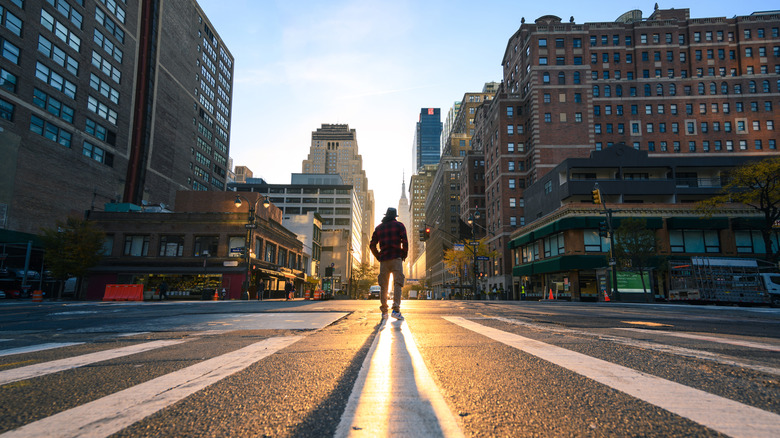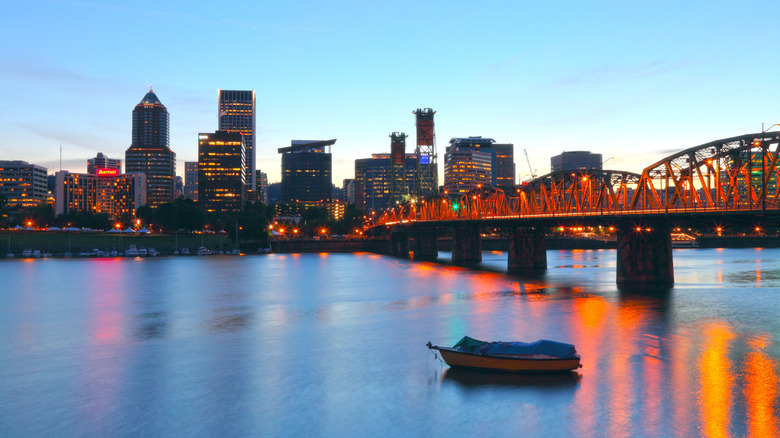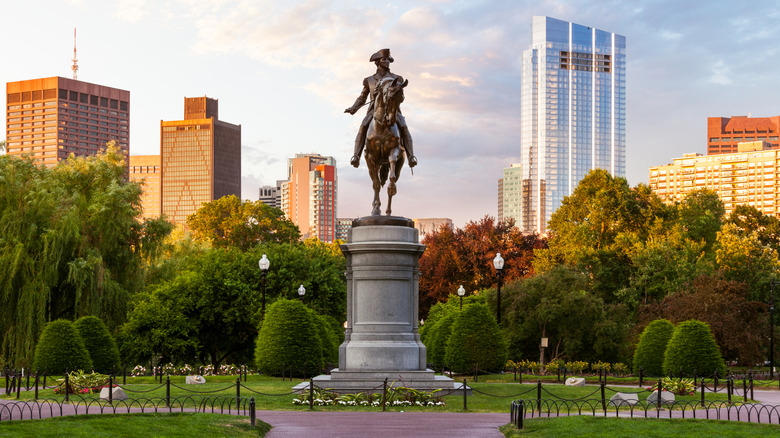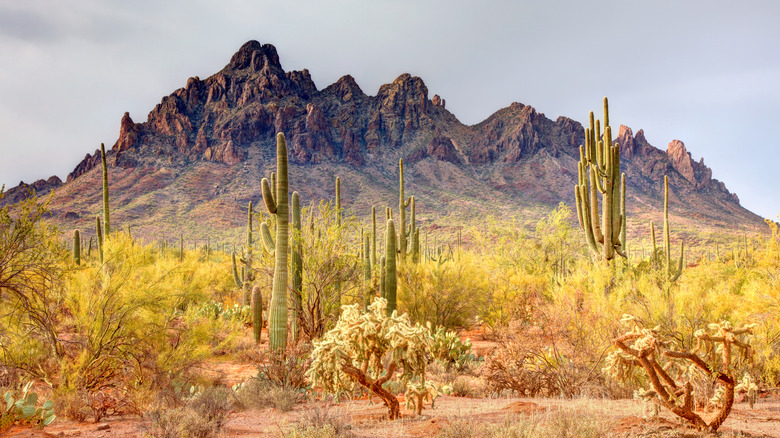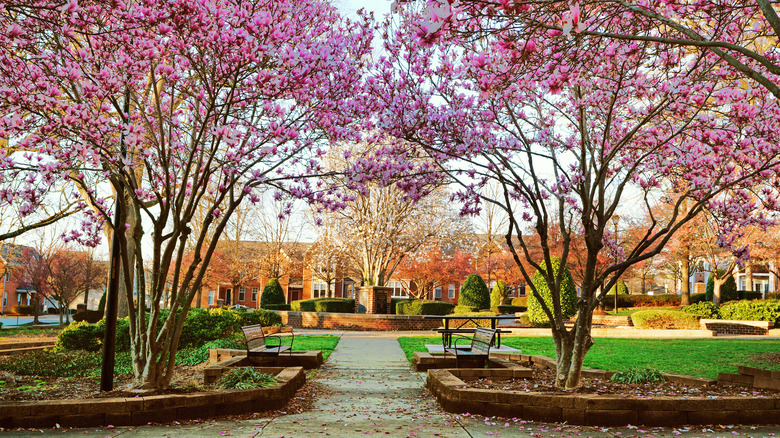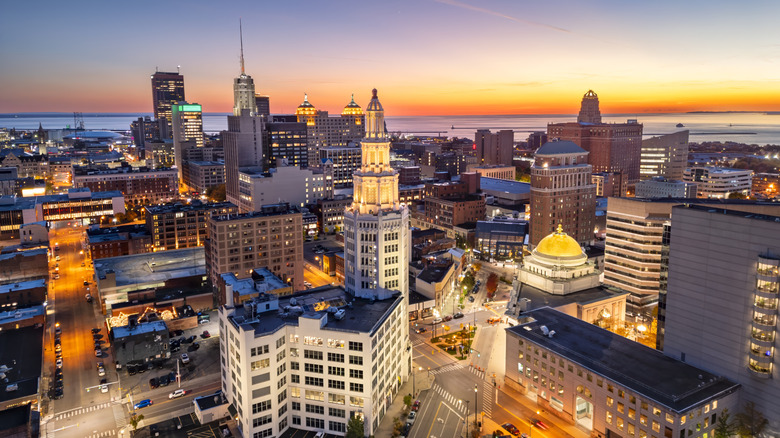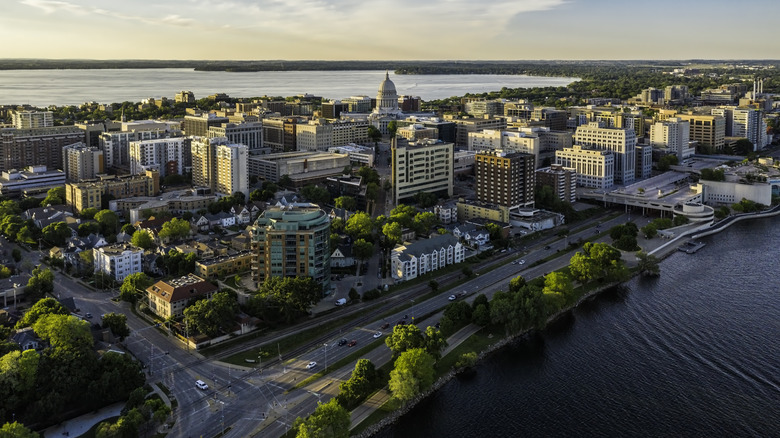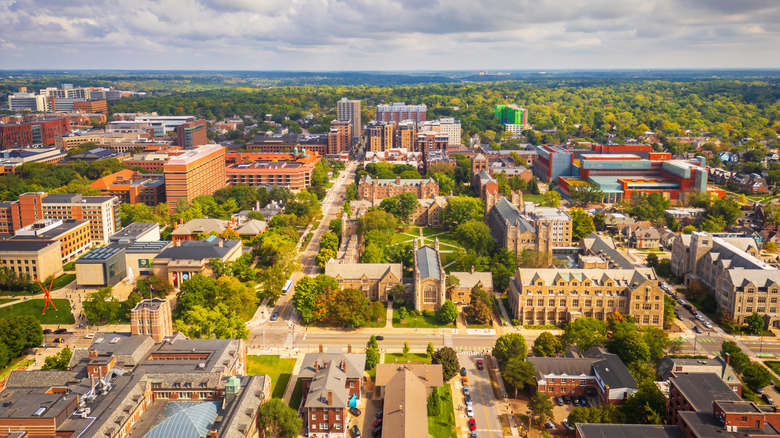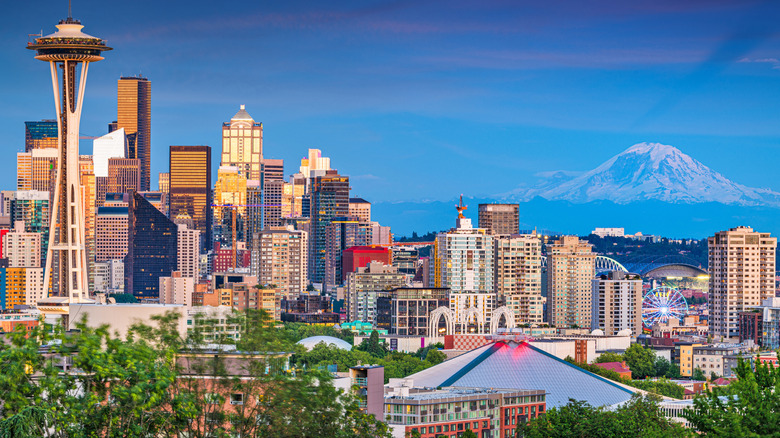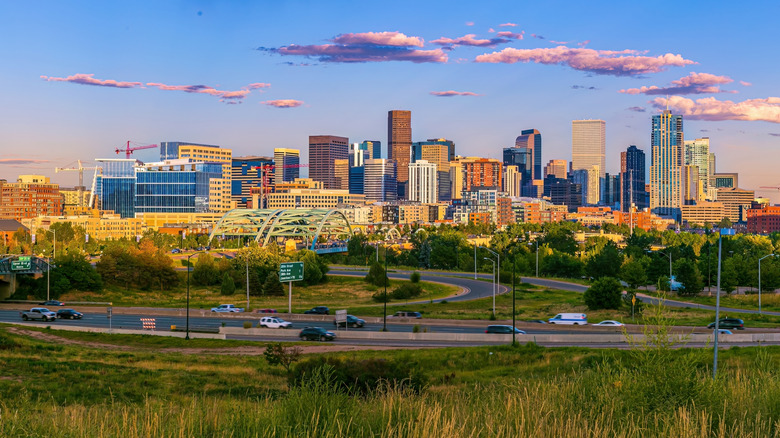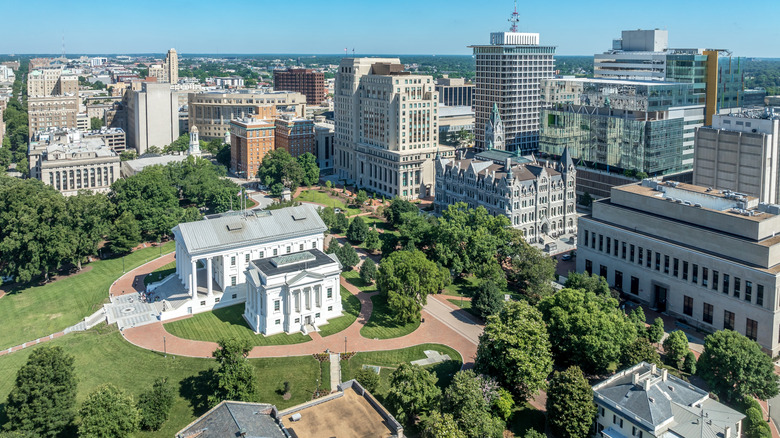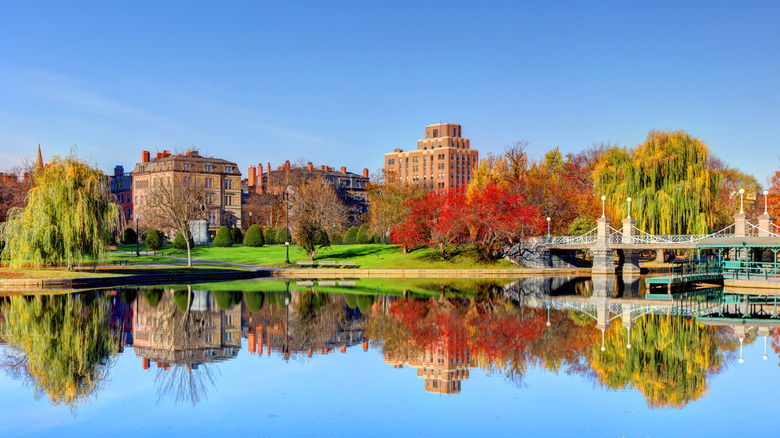10 Of The U.S. Cities Best Equipped For Withstanding Climate Change Damage, According To Research
As divisive issues go, there's perhaps none as impactful as climate change. Communities across the world are grappling with the long running effects of a problem at the very heart of human habitation. The science is clear: The more we do the greater the effects become (via EPA, NASA, and university outlets like Cornell). Certainly, there's something to be said for the Earth's natural cycles, but there's also no denying the shift that human activity has created — most prominently over the last 250 years and coinciding with the industrial revolution. As production across the board increases, so too do the global averages in temperature and sea level measurements.
These changes are gradual, sometimes not noticed at all over the span of many years. This partially underpins much of the problematic feelings that frequently muddy the waters of progress toward climate resiliency. Because the consequences are hard to grasp and exist out in the future, there's often a general lack of urgency in solving these problems, too.
But widespread climate-driven migration is already underway, and it can be seen prominently in the United States — not just in the Global South, parts of the world that have historically contributed far less to the climate crisis but nevertheless tend to see increased impact risks. Columbia University published an article in late 2024 noting that 3.2 million U.S. residents have moved in the previous 20 years as a direct result of flood risks, and as many as 3 million now leave their homes annually to escape other conditions. Even so, all hope isn't lost, and numerous American cities are taking climate risks seriously.
Features of climate resilient cities across America
Climate change impacts people and places differently depending on a staggering list of factors. There's the obvious features of an at-risk area such as low elevation coastlines and frequent drought conditions that can induce wildfires more easily, as well as tornadoes, hurricanes, and earthquakes. Intense temperatures and massive rainfall statistics can also deliver inhospitable conditions to a community. Finding a city that's shielded from all or most of these natural weather and geographical features is perhaps the first step in the right direction.
"Here's your formula for finding a climate haven: A small city in northern latitudes, with abundant water and farmland, and a low risk of natural disasters," notes The Reliance School, a guide to building security and sustainability. But geography isn't everything. On top of a city that's protected from natural disasters, you'll need a government and local population that takes these risks seriously. A public-private partnership striving to enact climate resiliency can overcome some climate limitations while a favorably placed city with no appetite for these important works can easily allow natural gifts to wither.
Think tank International Institute for Sustainable Development (IISD) suggests natural flood defenses aimed at redirecting rising waters, urban ecosystem construction, and technological upgrades like smart grids can all play an important role in tackling these threats. Meanwhile, a 2024 review published in BMC Public Health highlighted important features of climate-adaptive cities, focusing on "effective resource management, future-oriented planning, education, knowledge utilization, innovation in governance and industry, decentralized management, and low-carbon economy." Others, like the University of Texas at Austin, have highlighted the importance of localized knowledge, with communities driving the conversation surrounding how best to implement tailored resiliency strategies. With all of this in mind, the following are 10 of the best-equipped cities in the U.S.
1. Portland, Oregon
Portland has long been one of the United States' most climate-focused cities. The Global Warming Reduction Strategy was unveiled by the city in 1993, making it the first of its kind. In the years since, Portland has continued to stand out for sustainability and climate-focused urban planning. The city features as one of the country's leaders in public transportation adoption. Commuters have the city's light rail network as well as a variety of bike paths and bike-friendly amenities that make the car something that isn't strictly necessary to move around the downtown community.
Oregon finds itself located in a beautiful part of the country, and is advantageously positioned to avoid issues like frequent extreme heat (though experts state that the temperature is increasing in the state), tornadoes, and hurricanes. Greenspace is abundant throughout Portland and its surrounding suburban landscapes, too. Public officials have prioritized a transition toward decarbonization, and actively seek out energy resources, urban planning strategies, and related avenues that minimize the importance of fossil fuels in the local economy. Targets include a phase out of gas leaf blowers, transitioning away from traditional gasoline-powered vehicles, and sustainable deconstruction (rather than standard demolition).
2. Boston, Massachusetts
Founded in 1630, the capital of Massachusetts stands among some of the oldest European establishments on the continent. Boston is a bustling haven of history with all the trappings of modern charm rolled together, and has even been named the world's most beautiful winter city. Located in the northeast, Boston is sheltered from most aggressive weather conditions that afflict the nation, although New England is susceptible to intense snowstorms (known as Nor'easters). The Washington Post classifies Boston and its immediate surrounds as a low climate risk, although the rest of the state is in the medium or high category.
Boston has long been known as a hub for progressive thinking, and this includes critical approaches to climate change. It created a new Climate Council in 2024 to streamline the community's environmental actions. Specifically, it has targeted normal functions like waste production as important points of focus in reducing the city's overall environmental impact. A committed shift to renewable energy resources to power infrastructure is also underway.
The community's goal is to achieve carbon neutrality by 2050. It seeks to achieve this through direct clean energy production within the city through the installation of collection tools. There's also a focus on climate justice built into the strategy, with careful attention paid to cost-effective and sustainably powered public transportation services. This is all part of the Boston Green New Deal, and includes other initiatives like shoring up vulnerable parts of the city that would otherwise be impacted by sea level rise (such as low-lying Back Bay).
3. Tucson, Arizona
Arizona is advantageously positioned to take advantage of solar power, and the community has responded to this energy resource in an overwhelmingly positive fashion. The state is among the nation's leaders in small scale solar energy production, and ranks third in the percentage of homes participating in local solar production (at 12% compared to a national average of 4.4%), per the National Renewable Energy Laboratory (pdf). Tucson isn't tucked away in the nation's northern fringes, but that doesn't mean it's doomed to wilting climate resiliency. The desert region that Arizona occupies has provided a challenge to its resident population for millennia, and yet indigenous communities of old and modern residents have made this place a landscape of many comforts.
Arizona is certainly no stranger to intense heat, but has made that issue a cornerstone of its climate action plan. A three-pronged approach has been developed by Tucson to tackle this pressing issue: cooling the community through tree planting efforts and key infrastructure inclusions, targeting heat in the home, and educating residents about risks and emergency procedures. Coupled with efforts to implement expanding solar adoption, the city is making great strides toward climate resiliency. Indeed, according to Hippo Insurance, Tucson ranks third among all U.S. cities in its climate resiliency. Moreover, in 2023, the state of Arizona joined the U.S. Climate Alliance, so Tucson and other communities throughout the state will be doubling down on their climate preparedness planning in the coming years.
4. Raleigh, North Carolina
The Carolinas teem with intense natural beauty. Some of the country's most venerated old-growth hardwood forests can be found in must-see national parks on the East Coast, and that's to say nothing of the Blue Ridge Parkway that meanders its way through North Carolina on its iconic voyage across Appalachia. The state's wildlands are largely spared the fiery fate of those out west since it's not susceptible to the same dramatic drought conditions that add to the instability of many U.S. forestlands. Raleigh, the capital, is a particularly well-positioned community, and benefits from an inland position that also protects residents from future threats of sea level rise as well as annual hurricane risks.
Raleigh is introducing new EV charging capabilities throughout the community and looking to convert its fleet of vehicles (numbering nearly 5,000) to all electric in the coming decade. It's a leader in community engagement as well, with some of the highest buy-in rates among residents making the conversion to installing panels and using solar energy in their homes. The city is focused in large part on getting low and middle-income households on board. Reducing emissions by 80% ahead of 2050 is part of the picture, and the community is devoted to improving sustainability among the agricultural sector, too. Raleigh's overall climate action plan won the Sustainable Communities Award in 2024, signaling the importance of these elements in its long-term planning.
5. Buffalo, New York
A surprisingly quaint city in upstate New York, Buffalo is known as a climate haven city and is the U.S.'s fourth safest city in terms of natural disaster vulnerability, per Be In Buffalo. It's bristling with iconic architectural treasures that only make it stand out more when considering its value as a potentially soft landing spot. Climate havens are cities theorized to be some of the best places for migrants who are picking up stakes as a result of climate change issues in or near their existing homes.
Coastal residents along both sandy shores of Florida, for instance, are at risk of being displaced in the coming decades. Moving to a climate haven city like Buffalo gives relocators a fresh start in a community that isn't threatened by the same issues. Hurricanes are a major problem for Floridians, too, but they dissipate in large part after moving up along the southeast. Even storms that retain some of their power as they move north over the Atlantic don't threaten these ideally-located communities. The same can be said for other disaster conditions like tornadoes and earthquakes. These cities can see heat waves in the summer months, but their northern positioning also offers good defense for residents against prolonged, dangerous temperatures.
Buffalo is one of the preeminent locations blessed with gorgeous natural geography and climate defense for its residents. On top of these imbued characteristics, the city also sports the cleanest energy production pipeline in the nation thanks to Niagara Falls' hydroelectric capabilities.
6. Madison, Wisconsin
Madison is a firm stalwart hidden away within the Midwest. Located between inland Lakes Mendota and Monona, Madison isn't threatened by the same sea change hazards that impact ocean and even larger lakeside coastlines. The city is considered a climate haven, much like many other northern communities that feature high quality climate resiliency action. It has focused intently on converting its electricity usage to 100% renewable energy sources. Included in this pledge is a fully formed plan to implement new mass transit options that run on renewable energy, as well.
Madison's winters do get cold, but part of the appeal of climate haven communities is the understanding that a changing environment across the Earth is going to warm every part of it by at least a small factor. Communities that experience deep cold snaps through the winter will likely see their temperatures get a bit milder. This certainly isn't a good outcome for the planet and its multitude of people living closer to the equator, but for anyone who can, relocating to a northern hamlet of greater year-round comfort can be a major benefit. Madison's commitment to renewable resources, improvements to its public transportation infrastructure, and its natural environmental gifts make this a place that's better prepared to weather a changing planet than most.
7. Ann Arbor, Michigan
The Great Lakes see their fair share of well-endowed cities when it comes to climate resiliency. Environmental protection has long been a pillar of communal thought in places like Michigan, and so it's no surprise that the bustling college town of Ann Arbor would take a prominent place among climate resilient communities. The city has long been active in efforts to significantly curtail emissions and is no stranger to investing substantially in achieving these and other goals. Ann Arbor is seeking a 90% reduction by 2050 in its long term vision. It's also chasing carbon neutrality by 2030. Ann Arbor has also prioritized generating municipal energy needs locally and from renewable sources. Current targets place a 100% renewable sourcing date at 2035.
Energy stewardship isn't the only claim to fame that Ann Arbor exhibits, though. At present, 80% of the city's drinking water is sourced from the Huron River, meaning there's no long supply chain required to deliver clean, usable water resources to residents. This is energy efficient, to be sure, and stands as a testament to Ann Arbor's position as a community that understands the intimate relationship between its people and the geography of its place. Residents don't need to adjust their behaviors or expectations to become climate protectors, they already are.
8. Seattle, Washington
Seattle is vulnerable to sea level rise and has experienced intense heat waves in the past, but it enjoys a low overall risk of climate change-based events. The maritime metropolis remains a fantastic candidate for those considering a move as a result of climate alteration in their own backyard. With these vulnerabilities on full display, Seattle has committed itself to improving the greenspaces throughout the city, and particularly those in lower income areas that are most dramatically effected by city heat islands that trap higher temperatures and stress residents' health and finances. It's also investing in seawall and storm drainage improvements, again with a particular focus rooted in climate justice initiatives that bring impoverished areas up to standard alongside more affluent neighborhoods.
The Washington state icon is also aiming to become carbon neutral by 2050 (although it's not currently on pace to meet this target). The city is installing electric vehicle chargers around the community and electrifying buildings. Seattle is named among the top American cities in terms of climate resiliency as a result of all these initiatives (Policygenius placed it in second place), even with its notable vulnerabilities. The Seattle Times stated that the city could become a national model for implementing climate resiliency, but noted that there's still admittedly a long way to go.
9. Denver, Colorado
Denver was named the most climate resilient city in America by Architectural Digest, and is consistently a leader when it comes to initiatives focused on environmental protections. It has made grants available to those with lower incomes to cover the expense of installing air conditioning systems as well as direct subsidies to help cover utility costs. This has made the community more hospitable to its residents, while efforts to continue expanding solar and other renewable energy production locally keeps things greener. Denver has also aggressively worked to plant trees around the city, focusing on reducing heat. Air quality is another big feature of Denver's overall climate impact focus.
Denver is among the American cities actively seeking to shift to a grid run entirely on clean, renewable energy. This priority has trickled down into the community, as well. Some of Denver's most iconic craft brewers feature production with 100% renewable energy standing behind their products. Additionally, Denver International Airport has been named the country's most sustainable air transit hub.
10. Richmond, Virginia
A thriving Virginia town, Richmond features cold but largely bearable (maybe even mild) winters and is built around the tranquil James River. Richmond is an urban landscape, but one that already features notable green spaces that help limit its natural heat capture. Additional steps to reduce the impacts of urban heat islands are an integral component of the Richmond 300 Master Plan. This strategic framework for taking Richmond into the future seeks to make the community's neighborhoods more walkable and create additional public transportation systems that will reduce its population's reliance on cars throughout the everyday hum of city life.
Many of Richmond's strategic planning focuses specifically on the increased risks that its current urban landscape places on older, disabled, and impoverished residents. Climate justice and equitable urban planning help elevate the value that Richmond brings to a wider cross section of potential relocators seeking to get away from sea level rise, extreme heat, or other natural disaster risks. U.S. News and World Report called Richmond one of the most climate resilient metro areas in the U.S. in 2021, and continued steps forward have only helped cement that standing.
Methodology
Each city included here has been spotlighted by academic research and other sustainability-focused outlets. Most can be found in geographically favorable northern regions and are spared from the most intense natural disasters that can impact the country. Each city sports local government infrastructure tasked specifically with combatting the effects of climate change on their communities, sometimes with a track record going back decades. Numerous cities listed are also located in states that have made important strides toward climate resiliency, providing an important partner in these efforts.
